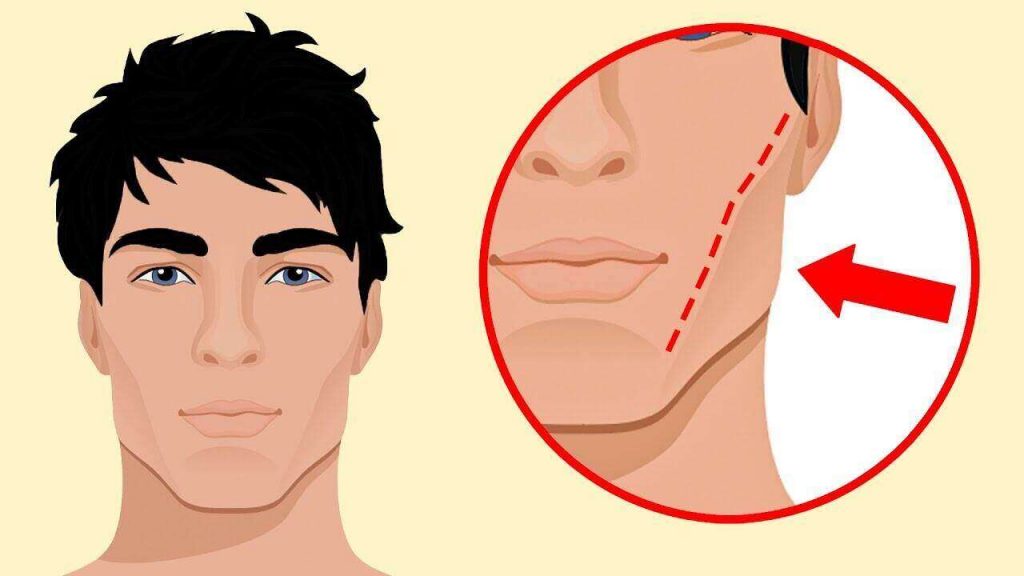Mewing is a type of tongue posture that might improve appearance of the jawline. Mewing is performed by pressing the tongue against the roof of the mouth, closing the lips, and clenching the teeth. The benefits of mewing are said to include a more defined jawline and better chin and nose alignment.
Anecdotal evidence suggests that mewing can also help with:
- Apnea (sleep deprivation)
- Difficulty with breathing and swallowing.
- Speech problems.
- Malfunction of the temporomandibular joint.
- Sinusitis
Mewing is just the positioning of the tongue against the roof of the mouth, according to internet sites that endorse the method. The entire tongue should be lying between the molars on the roof of the mouth.
When the mouth is closed, leave the tongue in this position until it returns to its natural resting position.
If people aren’t used to holding their tongue in this position, they may find it exhausting at first. If someone is doing it appropriately, they should feel mild pressure across the middle of their face, jaw, and chin.
Mewing’s Origins
Mewing was invented in the United Kingdom by a father-son team of orthodontists. Dr. John Mew, an orthodontist in England who is now in his 90s, came up with the concept of mewing. In the 1970s, Mew began treating patients using mewing and palate expanders instead of more standard orthodontic procedures like braces.
Unlike most orthodontists, Mew was more concerned with appearance than straightening teeth. He wanted to assist patients in developing a strong jawline.
Mew’s kid went on to become an orthodontist. Mike Mew is well-known for carrying on his father’s tongue posture and facial structure teachings. He works as an orthodontist in London.
John Mew created the London School of Facial Orthotropics, which the Mews are both affiliated with. Despite the fact that they were both certified dentists and orthodontists, John Mew’s license was recently revoked, in part due to the controversy surrounding him. Mike Mew was also expelled from the British Orthodontic Society.

Does Mewing Actually Work?
It’s worth noting that Mew’s mewing as shown on TikTok isn’t exactly what he planned. Mewers on TikTok and YouTube appear more concerned with reaching a certain aesthetic – even if it’s simply for a 60-second video – than with straighter teeth and better breathing. “I would believe that a small percentage of the public is interested in long-term orthodontic movement through the act of mewing,” says Ryan Higgins, D.D.S., a dentist in California. “Most young folks are only attempting to improve the quality of their selfies.”
It’s almost as if modern-day mewing is “something you can do to capture a better image without the use of social media filters from sites like Instagram, Snapchat, and TikTok,” to use Higgins’ words. The jaw-slimming effects of mewing, like a filter, are just temporary. He replies, “Sure, manipulating your face muscles to modify the form of your appearance can work for a very brief period of time.” “Every time a bodybuilder flexes on stage, they do it.” However, your soft tissue will return to its resting posture as soon as you relax your stiff muscles, making mewing a very temporary way to restructure the jawline and eradicate a ‘double chin.'”
Dentist Richmond states that even if you practice this on a regular basis, any jaw-sculpting outcomes will most likely be temporary. The persistent adverse effects of mewing, on the other hand, can last a long time. Kalasho notes, “The procedure is focused on the strengthening of certain face muscles.” “As a result, if you cease mewing, the effects may fade.” Mewing, on the other hand, has its drawbacks, since it forces you to keep your teeth touching throughout the day, potentially creating a lot of “tooth wear” and enamel fissures, according to Kalasho. On the other hand, Mewing “may cause pain in the back of the neck, in the mouth, and you might possibly cause misalignment of your teeth” if done incorrectly.
But what about all of TikTok’s “evidence” of more defined jawlines? Although moving your tongue may temporarily define your jaw, according to Jeffrey Sulitzer, D.M.D., chief clinical officer at SmileDirectClub, there is “no scientific evidence to support this practice.”
What is the Best Way to do this exercise?
Orthotropics were developed by John Mew to aid youngsters with misaligned teeth or poor facial structures without the use of braces or dental surgery. He believed that by correcting face posture, such as pressing the tongue against the roof of the mouth while keeping the lips closed and teeth aligned, these issues might be avoided. Mew also suggested eating more hard foods and fewer soft, processed items, based on the theory that chewing harsher foods will strengthen facial muscles.
While Mew’s tactics were intended for youngsters, enthusiasts popularized them for adults and coined the term “mewing.”
Mewing steps are simple:
- Allow your mouth to rest properly.
- Lightly press and flatten your tongue on the roof of your mouth.
- Make sure your tongue is resting exactly behind your front upper teeth, not against them.
- Try pressing the back third of your tongue on the back of your mouth’s roof. Make the “ng” sound (or utter a word that ends in those letters, such as “sing”) as an exercise to assist your tongue get into this posture.
- Maintain a closed mouth with your teeth lightly resting together.
- Don’t clench the teeth too hard, otherwise, this can cause jaw pain.
Mewing exercise can bring a range of benefits, including:
Enhancement of facial appearance
- Speech impairments are corrected.
- TMD (temporomandibular joint dysfunction) is less common (TMJ)
- Sleep apnea and snoring are reduced.
- Sinus infections and sinusitis are less common.
- Nasal congestion is reduced.
- Breathing and swallowing have improved.
However, online mewing sites caution that the results, particularly in terms of facial attractiveness, may take a long time to materialize. According to Mewingpedia, the majority of people will notice benefits in 3 to 6 months, while others may have to wait 1 to 2 years.
Common Mewing Errors
This exercise should cause you to feel pressure on your face, but it should not cause you any discomfort or suffering.
- Don’t breathe via your mouth; instead, attempt to breathe through your nose as much as possible.
- Don’t merely press the tip of your tongue against your teeth. Rest completely without obstructing your airway.
- Close your mouth rather than clenching it.
Who was the first to discover Mewing?
According to Dr John Mew, this is the “Proper Tongue Posture,” which has a number of health benefits. Dr John Mew determined that crooked teeth are caused by aberrant growth in the mandible and maxilla, using Wolff’s rule as a guide for lower and upper jaw.
“The optimal development of the jaws and teeth is based on good oral posture with the tongue lying on the palate, the lips sealed, and the teeth in light contact for between four and eight hours a day,” according to Dr. Mew’s 1981 publication “The Tropic Premise.”
Is There a Risk in Mewing?
Yes. Your jawline is a complicated machine. It can’t be changed without affecting a lot of other things.
Even if you are successful in modifying your jawline or the positioning of your lower jaw for an extended period of time, you may experience other issues, such as:
- Teeth misalignment
- Upper and lower jaw misalignment
- At the hinge of your jaw, you may have pain or dysfunction (TMJ pain)
- Teeth that are loose or chipped (from misalignment or pressure)
Any alterations in the way you utilize your jaw should be done under the supervision of a dentist or orthodontist. Before you try something new, talk to a Townsville dental clinic.
Should You Try Mewing?
If you want straighter teeth or a better night’s sleep (due to better breathing), it’s best not to take matters into your own hands and instead seek medical advice. A dentist or orthodontist can help you figure out the best way to deal with crooked teeth, misalignment, and other mouth issues.
Even if you only want a slightly more sculpted jawline, Sulitzer underlines the significance of receiving professional help rather than doing it yourself. He states, “I would not promote this procedure to my patients, certainly not without the supervision of a dentist or orthodontist.” That sentiment is shared by other professionals. “If you’re attempting to change the shape of your face, you want to make sure you’re doing it correctly,” explains Zainab Mackie, D.D.S., alias @drzmackie “Your TikTok Dentist” on the site. “Self-diagnosis is never a good idea. This is why you should contact a physician or dentist and make sure you get their advice.”
You can probably expect this one, like so many other dental-related fads before it — using magic erasers on teeth or oil pulling — will die out as fast as it soared to viral status. Yes, according to Higgins, mewing can sharpen the jawline and “remove the ‘double chin’ for that perfect picture.” However, once the flash has gone off, relax your mouth and muscles. If you still have worries about your appearance or health, use your tongue to speak with a dental professional who can provide you with legitimate, evidence-based guidance.
Advantages of Mewing
So why would you jump right in and begin performing these strange tongue exercises? The proponents appear to adore it. This, according to proponents, can help with a variety of issues, including enhancing facial structure.
- Speech problems
- Sleep apnea is a type of sleep apnea
- Breathing difficulties
- Difficulty with swallowing
- Infection of the sinuses
The health reasons are more difficult to pin down, but the primary motivation for people to start mewing appears to be a greater focus on enhancing their jawline.
Why are People doing this Mewing?
Some of us aren’t crazy about the form or contour of our jawlines. Also known as our face profile. AKA our “short” jaw or double chin. Exercise is far less intrusive than anything drastic like orthognathic surgery on your jaw, right? Because mewing is something you can learn on the internet and it’s virtually free, most people give it a shot because they figure “what harm can it do?”
Excess tissues under the jawline, a sunken jaw, or a double chin are common concerns for people who mew frequently. They hope that by doing facial exercises, they may be able to assist tone those tissues. They will be able to decrease drooping and generate a slimmer-looking profile in this manner. Why not attempt exercises on your face if they benefit other parts of your body? Right?
While orthodontic doctors regularly suggest oral therapies, mewing is one that people discover and practise on their own thanks to online research. That doesn’t always mean it’s incorrect. However, it does mean that you might invest a lot of time and attention into a process that doesn’t always work for your needs.
Conclusion
What exactly is mewing? Dr Mike Mew, a British orthodontist, popularised a specific sort of facial/tongue/jaw workout. It’s one of the many sorts of oral exercises that have been used in dentistry and orthodontics during the last century. This jawline exercise is pressing your tongue on the roof of your mouth in a specific way in the hopes of toning the jaw, chin, and neck tissues nearby.
The worst that can happen if you start mewing is that you will experience muscle discomfort or headaches as a result of the secondary tension created. It doesn’t hurt to try, but you’ll probably have to “mew” for years before you notice any substantial changes in your facial features. It’s possible that the time and effort will be in vain.
The most effective orthognathic treatments, in theory, will be used when your facial bones are still developing. Specifically, between childhood and adolescence. There’s just so much you can do non-surgically to change the contour of your face tissues around the bone after your mouth and skeletal anatomy are fully developed. You can tone them, but it won’t necessarily replace or eliminate the need for surgery. Working with an orthodontist or cosmetic dentist will yield better outcomes than trying to mew on your own.
When in doubt, consult an orthodontist before attempting any sort of self-treatment, including mewing.





![10 Countries With the Best Healthcare in the World [Statistical Analysis] Countries With the Best Healthcare in the World](https://articleify.com/wp-content/uploads/2025/07/Countries-With-the-Best-Healthcare-in-the-World-1-218x150.jpg)












![10 Countries With the Best Healthcare in the World [Statistical Analysis] Countries With the Best Healthcare in the World](https://articleify.com/wp-content/uploads/2025/07/Countries-With-the-Best-Healthcare-in-the-World-1-150x150.jpg)










